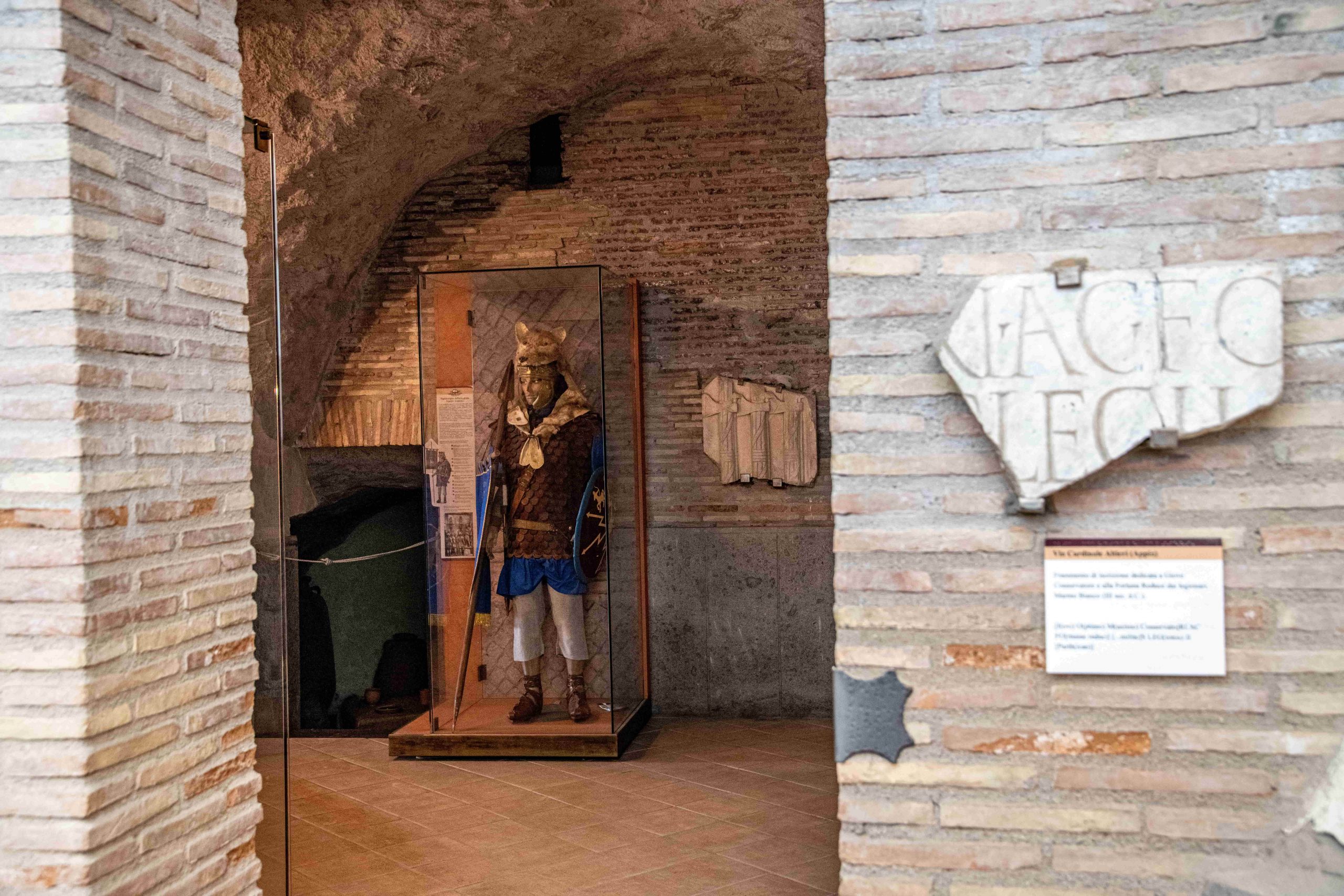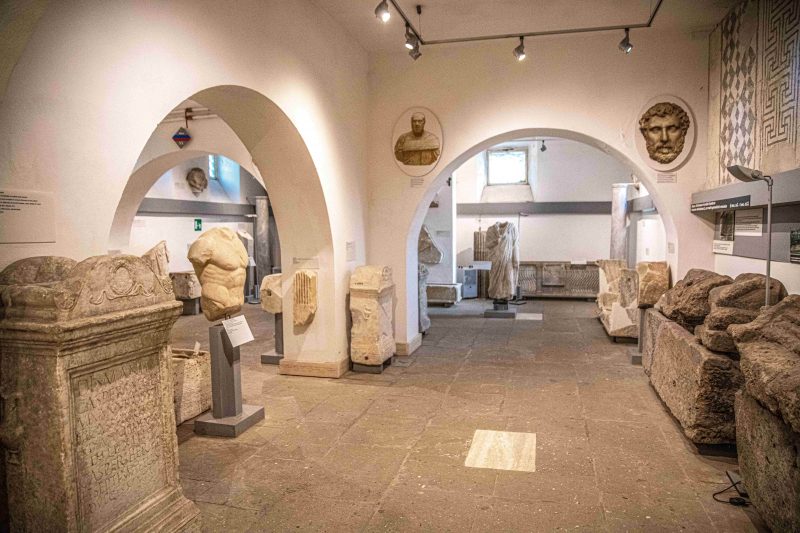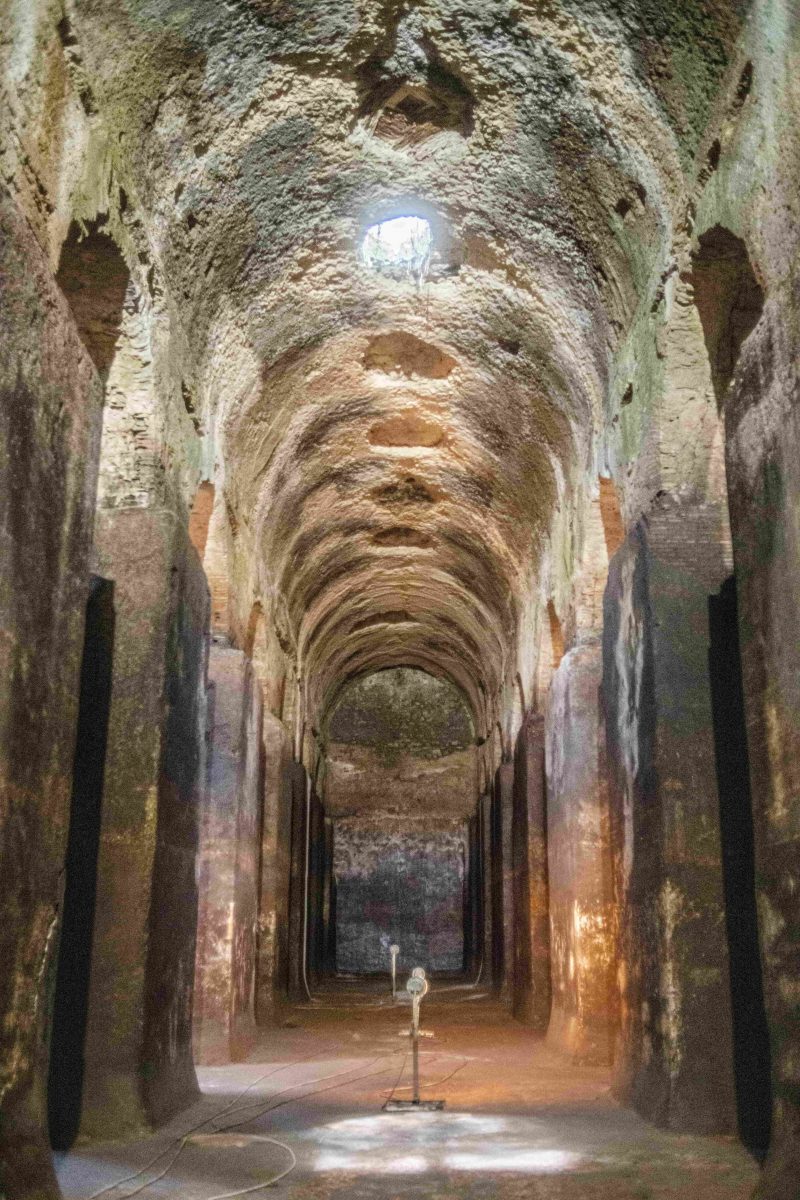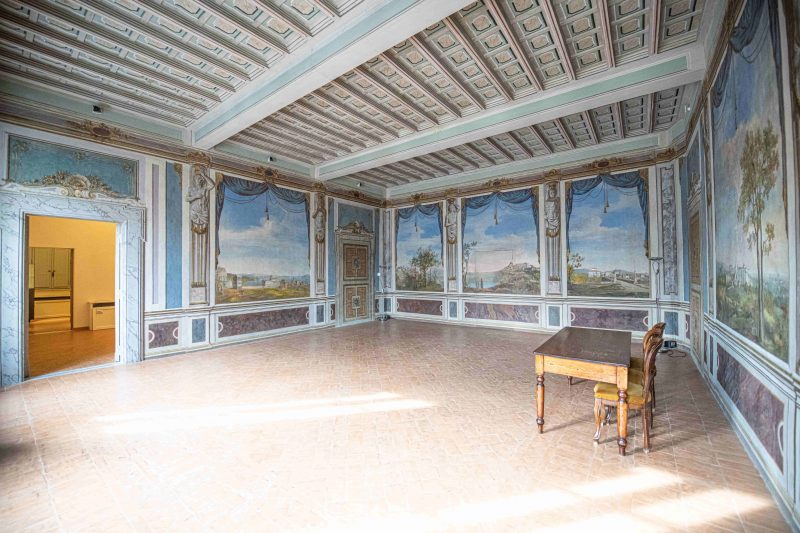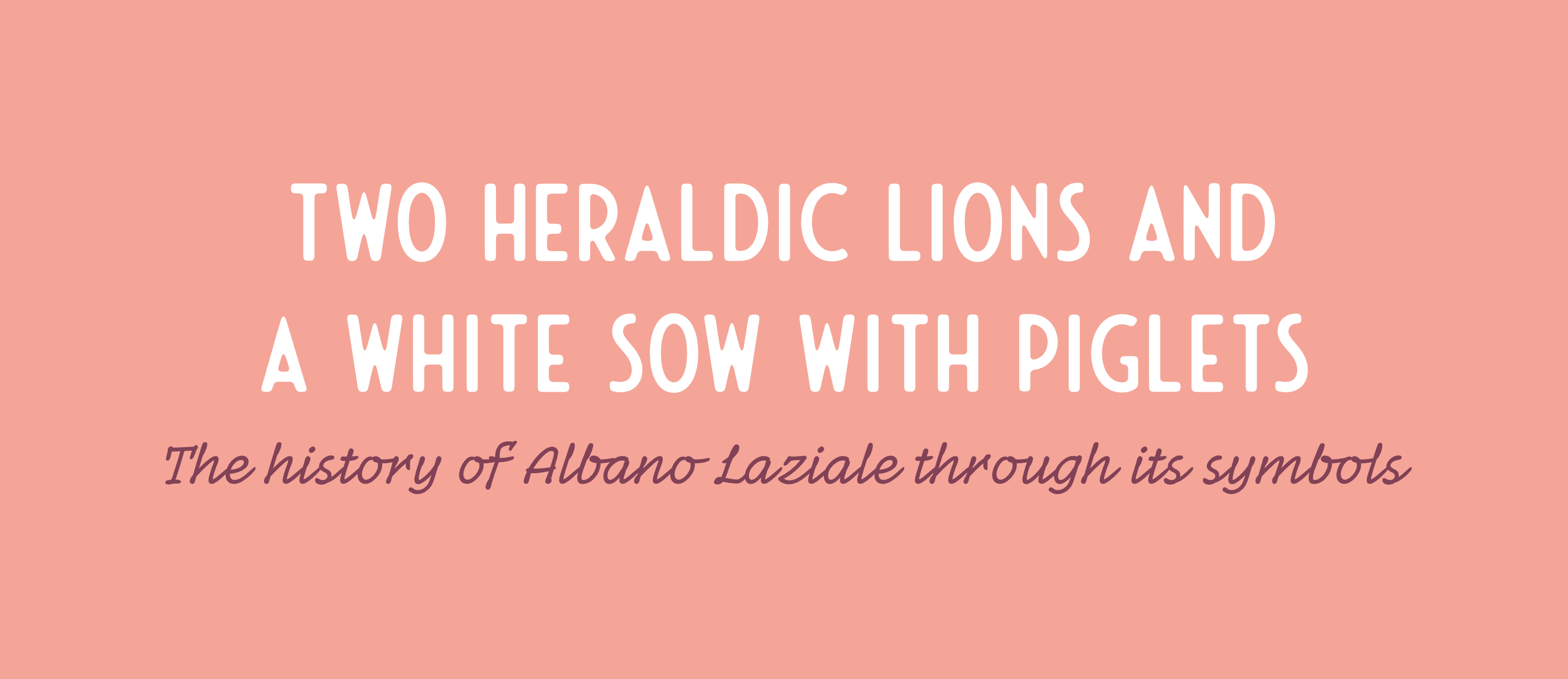
Area 1 – Itinerary 2
Two heraldic lions and a white sow with piglets: the history of Albano Laziale through its symbols.
-
Porta Pretoria (place of interest I)
-
Tomb of the Orazi and Curiazi (place of interest II)
-
Cisternoni of Albalonga (place of interest III)
-
Church of Santa Maria della Rotonda (place of interest IV)
-
Severian Amphitheatre (place of interest V)
-
Second Parthian Legion Museum (museum I)
-
Church of San Pietro (place of interest VI)
-
Diocesan Museum (museum II)
-
Villa Ferrajoli Civic Museum (museum III)
A flourishing town of about 42,000 inhabitants only 25 km from Rome, Albano Laziale has a rich history visible in its heraldic symbols and coats of arms. In the historical centre, visitors will notice the peculiar municipal coat of arms depicting a white sow on a verdant meadow, surrounded by piglets. This is a reference to the legend of Albalonga, which was founded by Ascanio on the spot indicated to his father Aeneas by a sow appearing to him in a dream, a metaphor emphasising the maternal role that the mythical city – from which the name Albano derives – had in relation to the Latin people.
The layout of the present-day urban centre is partly related to the configuration of the castrum – a rectangular fortified encampment enclosed by an imposing square wall. It was built by order of Septimius Severus between the end of the 2nd and the beginning of the 3rd century AD to house the Second Parthian Legion and guarantee its safety. The approximately 6,000 legionaries housed in the Castrum and their families located in the area just outside formed, together with artisans and merchants, a substantial urban aggregate.
Today, the Castrum is visible in parts of the surrounding wall and ruins of the imposing Porta Pretoria (on Via Corso G. Matteotti), which is the main three-arched access to the Castra Albana on the side facing the Via Appia Antica (now Viale Rinascimento). The monumental tomb known as ‘of the Orazi and Curiazi’, a funerary building of the late Republican age perhaps inspired by the Tomb of Arunte, stood along the Appian Way. Its traditional but unsubstantiated name is inspired by the famous duel between the two most representative families of Rome and Albano which actually took place at the fifth mile of the Appian Way.
Older monuments were incorporated in the area of the Castrum. The Cisternoni, a monumental water reservoir with a trapezoidal plan divided into five naves covered by barrel vaults supported by thirty-six pillars and fed by aqueducts and springs, ensured the surrounding area’s water supply. The complex of the Church of S. Maria della Rotonda, a nymphaeum from the 1st century AD, was transformed into a thermal environment with figured black and white mosaic floors in the 2nd century AD and then adapted for Christian worship from the 9th century onwards. The Severian Amphitheatre also dates back to this time. Located beyond the north-east side of the Castrum and originally 22 mt high, it is elliptical in shape. The arena is still clearly visible: the north side carved into the tufa outcrop, the triumphal entrances and the ground floor and first floor of the south side, which were supported by vaulted archways that sustained the tiers of seats and part of the triumphal entrances. Also present was a monumental thermal complex among the ruins of which the district of Cellomaio developed in the Middle Ages. The substructural rooms of the thermal baths house the Museum of the Second Parthian Legion, which is entirely dedicated to this military corps with full-scale reproductions of the military figures of the legion and archaeological artefacts recovered from the excavations of the Castrum itself.
In one hall of the baths is the Church of San Pietro, which features a coat of arms representative of Albano’s history. Depicting two heraldic lions facing each other, it is the symbol of the noble Savelli family, whose history is closely connected with that of the city. After the fall of the Roman Empire and the turbulent early Middle Ages, Albano came under the control of the family in the 10th century, and between the 16th and 17th centuries the city took on its present form through the construction of numerous buildings and, above all, the creation of an urban layout centred on two new transversal road axes, Via Aurelio Saffi and Via San Francesco d’Assisi.
The Savelli rule lasted until 1697 when the fiefdom was auctioned off and purchased by the Apostolic Camera, thus becoming part of the Papal State. Those interested in the history and ecclesiastical art of the Diocese of Albano can visit the Diocesan Museum, hosted since 2012 in Palazzo Lercari, the seat of the bishop since 1757. Those with a passion for Christian archaeology can also request to visit the Catacombs of S. Senatore.
The itinerary ends at the Civic Museum of Villa Ferrajoli, a small neoclassical villa dating back to the first half of the 19th century which features a permanent exhibition of more than two thousand archaeological artefacts narrating the history of Albano from the Lower Palaeolithic to the Renaissance.
Tips and interesting facts
– We advise our tourists to visit Albano and its treasures during the second week of September in order to experience the festive atmosphere of the Bajocco Festival. By planning an overnight stay, the visitor can spread the cultural outings over two days and indulge in an enjoyable evening during the street artists’ festival, which has always attracted both young and old alike.
Contacts and opening hours
Porta Pretoria
Albano (RM), Via Alcide De Gasperi
Info: +390693295443/4 | +39069323490 | www.museicivicialbano.it
Hours: the monument is visible externally; to enter, contact the Civic Museum of Villa Ferrajoli
Tomb of the Orazi e Curiazi
Albano (RM), Via della Stella
Info: +390693295443/4 | +39069323490 | www.museicivicialbano.it
Hours: the monument is visible externally; to enter, contact the Civic Museum of Villa Ferrajoli
Cisternoni of Castra Albana
Albano (RM), Via Aurelio Saffi
Info: +390693295443/4 | +39069323490 | www.museicivicialbano.it
Hours: by reservation during opening hours of the Civic Museum of Villa Ferrajoli
Church of Santa Maria della Rotonda
Albano (RM), Via dei Travoni
Info: +390693295443/4 | +39069323490 | www.museicivicialbano.it
Hours: by reservation during opening hours of the Civic Museum of Villa Ferrajoli
Severian Amphitheatre
Albano (RM), Via Anfiteatro Romano
Info: +390693295443/4 | +39069323490 | www.museicivicialbano.it
Hours: by reservation during opening hours of the Civic Museum of Villa Ferrajoli
Museum of the Second Parthian Legion
Albano (RM), Via Volontari del Sangue 6/8
Info: +390693263159 | +390693295443/4 | +39069323490 | www.museicivicialbano.it
Hours: 9am-1pm (Monday-Saturday, 1st and 3rd Sundays); 3:30pm-6:30pm (Monday and Thursday)
Church of S. Pietro
Albano (RM), Via Cellomaio 84
Info: +3906932141 | http://www.parrocchiadisanpietroapostolo.org/nuovosito/
Hours: always open during religious services
Diocesan Museum
Albano (RM), Via Alcide De Gasperi 37
Info: +390693269490 | info@museodiocesidialbano.it | www.museodiocesanodialbano.it
Hours: Tuesday 9am-1pm | Wednesday 9am-1pm/3pm-7pm | Saturday 3pm-7pm
Civic Museum of Villa Ferrajoli
Albano (RM), Viale Risorgimento 3 | www.museicivicialbano.it
Info: +390693295443/4 | +369069323490 | museo@comune.albanolaziale.rm.it
Hours: 9am-1pm (Monday to Saturday, 2nd and 4th Sundays); 3:30pm-6:30pm (Monday and Thursday)
